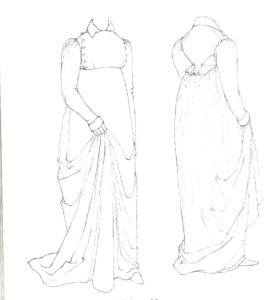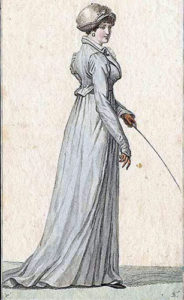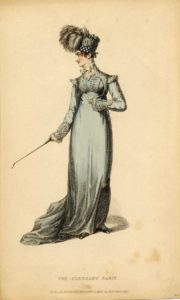In my last post I talked about the difference between morning gowns and walking costumes and other “informal” types of dress. Today we’re going to take a peek at riding habits.
Habits are something you’re probably all familiar with, at least in concept. They’re composed of an extra-long skirt and a spencer jacket. They might also involve a waistcoat and a habit shirt (worn with a cravat), or with a chemisette with a frill for a more feminine look. Sometimes they follow the high-waisted silhouette of the Regency era, and sometimes they don’t (a rare chance to show off your heroine’s waist!). Most often, they’re made of wool of some kind (stuff, bath coating, kerseymere, etc.), but there are extant examples of summer habits made of linen.
Habits are worn with some kind of hat, gloves, and either pumps or low half-boots (yes, pumps!). No tall riding boots for women as far as I can document (I’ve seen ONE cartoon of a woman in riding boots, but she was also shown with 5 o’clock shadow so we can hardly take her adoption of a masculine boot seriously).
First is this sketch of an extant 1810 habit by Janet Arnold for her book, Patterns of Fashion. It’s particularly great because Arnold details all the innards of the garment, including just how the skirt stays up (it’s really a “bodiced petticoat”), and we get to see the watch pocket, and the fact that their are hook and eyes connecting the jacket and the skirt. The pattern also lays out the series of tapes on the inside of the skirt that can be used to loop it up invisibly so that the train/length is hidden and you can walk.
Here are couple of basic habits. They could be masculine in style (as is the à la militaire one from 1817 with its “lacing”), or they could be feminine and frilly (I can’t find a public source for this one, so I’m sending you to Candice Hern’s site for all the filly glory).




